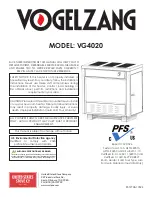
58
A chimney connector shall not pass through an attic, roof space, closet, floor, ceiling, or similar concealed space. Where
passage through a wall or partition of combustible construction is desired or necessary, the installation shall conform to
NFPA 211 or CAN/CSA-B365 requirements.
Whatever brand of chimney system is purchased for your Ovation installation, you must ensure that all chimney
manufacturer’s installation instructions are followed and that all national and local codes have been met.
OUTSIDE AIR COMBUSTION
It is imperative that the installer or homeowner ensures that a minimum of at least eight square inches (fifty square
centimeters) of outside air be admitted to the hearth room or directly to the stove. If installation allows, a four-inch
diameter pipe can be brought in through an exterior wall and connected, using the optional fresh air adapter, directly to a
catalytic stove.
Provision for outside combustion air may be necessary to ensure that fuel-burning appliances do not discharge products of
combustion into the house. Guidelines to determine the need for additional combustion air may not be adequate for every
situation. If in doubt, it is advisable to provide outside air.
Outside combustion air may be required if:
1
A catalytic stove does not draw steadily, smoke rollout occurs; fuel burns poorly, or back-drafts occur whether or
not combustion is present, or
2
Existing fuel-fired equipment in the house, such as fireplaces or other heating appliances smell, do not operate
properly, suffer smoke rollout when opened, or back-draft occurs whether or not combustion is present, or
3
The home is equipped with a well-sealed vapor barrier and tight fitting windows or has any powered devices that
exhaust house air, or
4
There is excessive condensation on home windows in the winter, or
5
A ventilation system is installed in the house.
If any of these or other indicators suggests that infiltration air is inadequate to sustain proper combustion in a catalytic
stove, additional combustion air should be provided from the outdoors. Outside combustion air can be provided to the
appliance by the following means:
Direct connection:
appliances can only use direct connection of outside combustion air if they are certified for this type
installation. Follow the Ovation instructions for direct connection of outside combustion air.
Indirect connection:
for appliances not certified for direct connection of outside combustion air, outside air can be
ducted to within twelve inches of the appliance.
Mechanical ventilation:
if the house has a ventilation system (air change or heat recovery):
A ventilation system may be able to provide sufficient combustion make-up air for a catalytic stove but the homeowner
should be informed that the ventilation system might need to be re-balanced by a ventilation technician after installation
of a catalytic stove.
CHIMNEY INSTALLATION
Install an approved chimney system in an interior
chase
of a home.
A chase is defined as a
n
enclosure (combustible or
noncombustible) that is built to cover the chimney system.
Interior chimney systems, with a properly constructed
chase, provide better overall stove performance. Performance is enhanced because the chase maintains heat around the
chimney thereby ensuring improved draft that improves venting (removal of spent exhaust gases.) In areas where
temperatures hover or remain below freezing, the use of an exterior chimney will only increase the likelihood of
problems. Some of these problems will be difficult starts, weak draft, high rates of creosoting, and increased maintenance
of the system. Exterior chimneys are also prone to down drafting and flow reversal. Installations, which are located on
lower floors in the house, such as in a basement, in combination with an exterior chimney are especially prone to flow
reversal.
Always follow the Chimney Manufacturer’s installation procedures over any recommendations this manual provides on
chimney systems. Installing the chimney must be in compliance with local codes, chimney manufacturer’s recommended
procedures, and the chimney must connect to the Country Flame stove in accordance with instructions provided.
Summary of Contents for Catalytic BBF Series
Page 4: ...4 SAFETY NOTES 2 3...
Page 29: ...29...
Page 49: ...49 FIGURE 24 GOLD DOOR WARNING LABEL FIGURE 25 EPA STOVE STICKER...
Page 50: ...50...
Page 51: ...51...






































